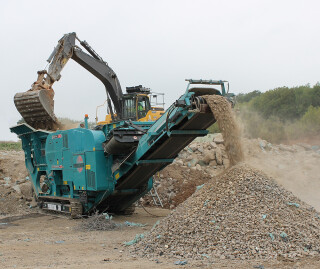Property investor Castleforge has appointed McGee to deconstruct the Cripplegate House office block in the City of London ahead of its redevelopment. And McGee has devised an approach that allows the steelwork to be reused in the proposed new structure.
On the site at 1 Golden Lane, the work will see half of the original building from the 1890s being retained in its current form with the deconstruction works taking place alongside it.
McGee is not simply recovering the steel sections so that they can be bolted back together in a different configuration for the new building. Instead, the proposed refabrication involves ribbon-cutting the existing beams to improve their structural properties.
“Refabrication is the process of re-constructing steel into its final form and ribbon-cutting is where the steel is cut to form a cellular beam,” explains Charlie Wedgwood, head of carbon at McGee.
“This involves using a plasma torch to melt the steel along a continuous cut line to create the ribbon. This process enables the parent section to become stiffer than it was before due to the increased second moment of area. This is upgrading its load bearing capacity – upcycling in the truest sense,” he adds.
Once the steel sections have been detached from the frame, the welded fixtures can be removed using a combination of techniques including burning and cutting, a process that McGee terms ‘de-fabrication’.
The steel is then shot-blasted clean and sent through the fabrication lines to create its final structural form. Wedgwood estimates that this process accounts for around 40kg CO2 emissions per tonne, a fraction of the 1,500kg CO2 per tonne emitted for the average UK hot-rolled section.
Before the refabricated sections can be used in the new building, they have to be tested and certified just like any new steel sections fresh from the rolling mill.
“We’re working back-to-back with a testing lab to gather all the necessary properties of the material to enable design, onward fabrication, and to satisfy insurance and warranty requirements,” explains Wedgwood. “We’re also doing some on-site hardness testing.”
According to McGee, this has never been done before on a reused steel section.
McGee has worked with the designers, several industry bodies and the client, Castleforge, to demonstrate that steelwork reuse in this scheme is viable, will reduce the carbon emissions and ensure the protection of the original building.
The deconstruction process will also involve the structural demolition of some existing reinforced concrete slabs, the roof and the façade of the building.
This scheme builds on similar work undertaken at other listed sites in London by McGee, including at Admiralty Arch and Claridge’s Hotel.
McGee managing director Seb Fossey says: “This is the first time that any project in the UK is targeting exact steelwork sections to be deconstructed, de-fabricated, recertified and refabricated for use in the redevelopment of the same site.
“It is our hope that by successfully delivering this scheme it will demonstrate that technical solutions around steelwork reuse are commercially viable for future schemes in the capital.”
McGee is hoping to reuse as much as two-thirds of the existing steelwork at Golden Lane.
“It’s important to note that the size and scale of the project is to balance the concept with the technical risk while trying to unlock the potential of the existing structures,” notes Wedgwood.
“We’re working with the team to integrate as many sections as possible, collaborating with the London Structures Lab team to help target specific sections that work within the parameters of the permanent works design.
“The key part of the trailblazing here is that we are taking steel from the building, upgrading it and integrating it into the proposed structure. The project is targeting 60% of the demolished steel to be reused in the development.”

Wedgwood believes that, as the first project to take steel sections from an existing building, refabricate them and incorporate them into a new building on the same site, 1 Golden Lane is a springboard that will launch the concept into the mainstream.
“I’m delighted that Castleforge has put their trust in the experience of our team to deliver this UK first,” adds Fossey. “We are committed to enabling lower carbon solutions through our high value engineering solutions.”
Meanwhile, Castleforge development manager Oliver Vickerage says that the Golden Lane project “is set to pioneer innovation in sustainable development of stranded City assets.
“Ambitious targets for best-in-class accreditations, including BREEAM ‘outstanding’, are being taken a step further through new opportunities for fabric retention, material re-use and the promotion of circular economy principals.”
Britain leads the way in recycled aggregate

More than a quarter of Britain’s construction aggregates come from recycled and secondary sources, according to a new industry report.
The Mineral Products Association (MPA) estimates that recycled and secondary materials accounted for nearly 70 million tonnes – or 28% – of the 253 million tonnes of construction aggregates supplied in Great Britain in 2021.
This places Britain among the leading recyclers of construction materials in Europe, the MPA says, ahead of other major economies, including France and Germany.
Recycled aggregates, around 63 million tonnes of which were produced in 2021, mainly come from construction, demolition and excavation wastes (CDEW), such as crushed concrete and brick, old rail ballast and material from groundworks.
The volume of recycled aggregate could be even higher, the MPA says, but is ultimately limited by the volume of demolition activity that takes place.
Meanwhile, secondary sources of aggregates, which accounted for the remaining seven million tonnes in 2021, are derived from industrial or extractive processes including the production of China clay, slate and chalk, plus glass reprocessing, mining spoil, incinerator ash, and slag from iron and steel production.
MPA director of economic affairs Aurelie Delannoy, who authored the report, says: “Heavy-side construction materials producers have become adept at making efficient use of available resources, producing recycled and secondary aggregates that meet stringent requirements for use across different construction sectors.
“Taken together with the restoration of mineral extraction sites to beneficial after use – principally nature conservation – our industry is delivering sustainable environmental results whilst others just talk a good game.”
She adds: “The absence of regular data monitoring about material arisings and their use makes it challenging to track the industry’s continuing progress and can fuel wider misunderstandings of the industry’s role in construction, both in terms of primary resource needs and the potential for greater use of materials that are either recycled or from secondary sources as part of the sector’s contribution towards green growth.”
MPA executive director Mark Russell said: “The contribution of recycled and secondary aggregates to total supply is an outstanding circular economy story that supports the UK’s green industrial revolution, the delivery of government infrastructure and housing ambition, and the resilience of the UK construction supply chain by promoting a diverse source of supply.
“Aggregates producers are recycling all available materials, and have been for many years, to meet our construction needs as efficiently and sustainably as possible. However, it is important to stress that primary aggregates are still needed to meet over 70% of total demand, a situation that will continue for the long term.”
Download the MPA’s 12-page report, The Contribution of Recycled and Secondary Materials to Total Aggregates Supply in Great Britain – Estimates for 2021 here: https://bit.ly/3KLWeIb
Got a story? Email news@theconstructionindex.co.uk



